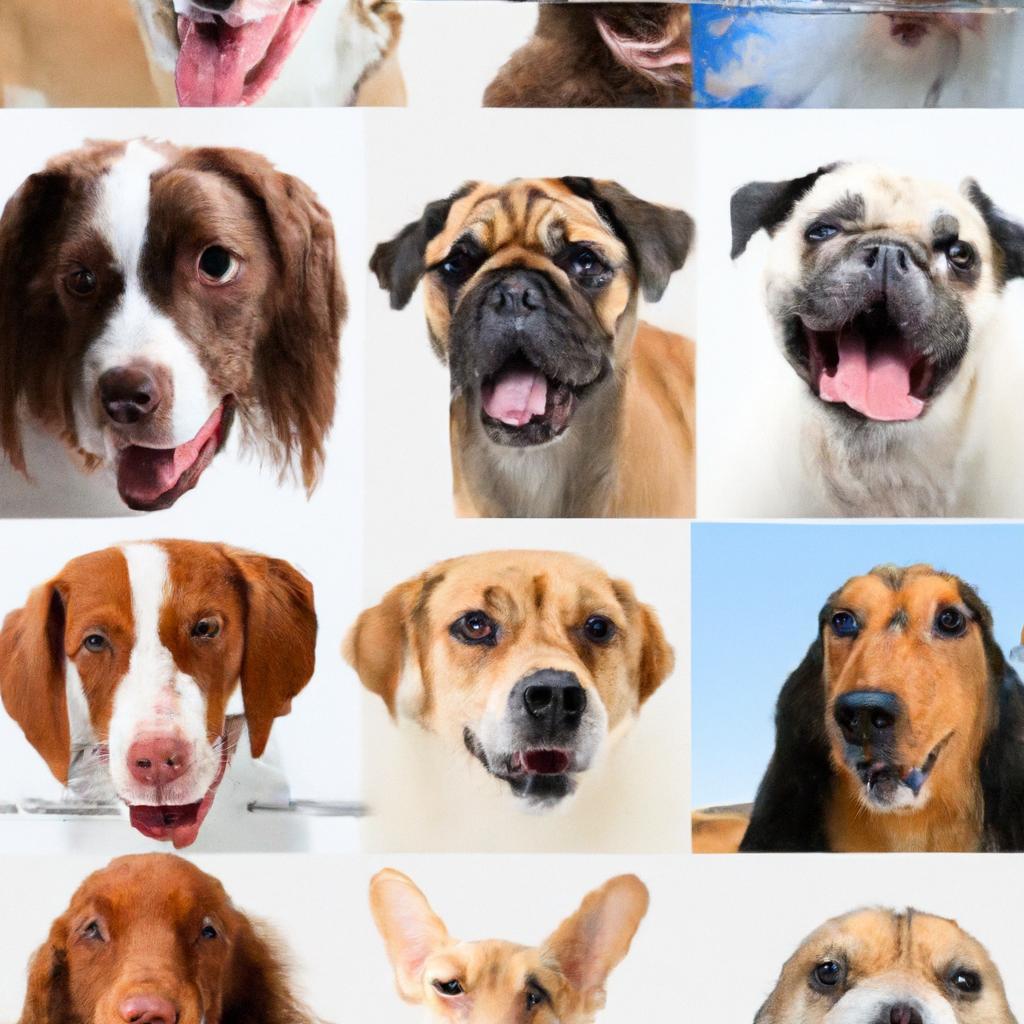In a quaint village, a curious child named Mia asked her grandfather, “Are there really 100 dog breeds in the world?” With a twinkle in his eye, he shared tales of his adventures with dogs of all shapes and sizes. From the tiny Chihuahua that fit in his pocket to the majestic Great Dane that towered over him, he explained that the world of dogs is vast and diverse, far exceeding just 100 breeds. Each breed tells a story, reflecting the rich tapestry of human companionship. So, let’s celebrate this incredible variety and embrace the countless breeds that enrich our lives!
Contents
- Exploring the Diversity of Dog Breeds Across the Globe
- Understanding the Criteria for Classifying Dog Breeds
- The Importance of Breed Recognition in Canine Welfare
- Recommendations for Choosing the Right Breed for Your Lifestyle
- Q&A
Exploring the Diversity of Dog Breeds Across the Globe
When it comes to the world of canines, the sheer variety of dog breeds is nothing short of astonishing. From the tiny Chihuahua to the majestic Great Dane, each breed has its own unique characteristics, temperament, and history. This diversity is not merely a matter of size and appearance; it reflects the rich tapestry of human culture and the roles that dogs have played throughout history. Understanding this diversity can deepen our appreciation for these loyal companions and help potential dog owners make informed choices.
Across continents, dog breeds have evolved to meet the specific needs of their environments and the lifestyles of the people who bred them. For instance, the Husky thrives in cold climates, originally bred for sledding, while the Basenji, known as the “barkless dog,” hails from Africa and was developed for hunting in dense forests. This geographical influence has led to a remarkable array of breeds, each adapted to its surroundings. The following are just a few examples of how geography shapes canine diversity:
- Working Dogs: Breeds like the Rottweiler and Boxer were developed for protection and labor.
- Herding Dogs: The Border Collie and Australian Shepherd excel in managing livestock.
- Companion Dogs: Breeds such as the Pug and Cavalier King Charles Spaniel were bred primarily for companionship.
Moreover, the classification of dog breeds is not static; it evolves as new breeds emerge and others fade into obscurity. Organizations like the American Kennel Club (AKC) and the Fédération Cynologique Internationale (FCI) recognize hundreds of breeds, each with its own standards and classifications. This dynamic nature of breed recognition highlights the ongoing relationship between humans and dogs, as we continue to shape and redefine what it means to be a dog in our society. As we explore the vast array of breeds, we uncover not just the physical traits but also the stories and cultural significance behind each one, enriching our understanding of these remarkable animals.
Understanding the Criteria for Classifying Dog Breeds
When it comes to classifying dog breeds, several criteria come into play, each contributing to our understanding of the vast diversity within the canine world. One of the primary methods of classification is based on **physical characteristics**, such as size, coat type, and color. For instance, breeds can be grouped into categories like toy, working, herding, and sporting, each reflecting distinct traits that serve specific purposes. This physical classification not only helps in identifying breeds but also aids potential dog owners in selecting a breed that fits their lifestyle.
Another significant criterion is the **historical and geographical origin** of the breeds. Many dog breeds have roots in specific regions, developed for particular tasks or environments. For example, the **Siberian Husky** was bred for endurance in cold climates, while the **Basenji** hails from Africa and is known for its unique yodel-like bark. Understanding these origins provides insight into the behavioral traits and needs of different breeds, allowing prospective owners to make informed decisions about which breed may be the best fit for their home.
Additionally, the **purpose or function** of a breed plays a crucial role in classification. Breeds are often categorized based on their original roles, such as hunting, herding, guarding, or companionship. This functional classification highlights the unique abilities and temperaments of each breed. For example, **retrievers** are known for their exceptional ability to fetch game, while **terriers** are often energetic and tenacious, making them excellent for pest control. Recognizing these functions can guide potential dog owners in choosing a breed that aligns with their expectations and lifestyle.
Lastly, the **genetic background** of dog breeds is an essential factor in classification. Advances in genetic research have allowed us to understand the lineage and hereditary traits of various breeds. This knowledge not only aids in identifying purebred dogs but also helps in recognizing mixed breeds and their potential characteristics. By examining genetic markers, breeders and owners can make more informed choices regarding health, temperament, and compatibility, ensuring a better match between the dog and its environment.
The Importance of Breed Recognition in Canine Welfare
Understanding the various dog breeds is crucial for promoting canine welfare. Each breed has its own unique characteristics, temperaments, and health predispositions, which can significantly influence their care and training. By recognizing these differences, owners and breeders can make informed decisions that enhance the quality of life for their pets. This knowledge not only aids in selecting the right breed for a family but also ensures that specific needs are met throughout the dog’s life.
Moreover, breed recognition plays a vital role in responsible breeding practices. When breeders are aware of the traits associated with specific breeds, they can prioritize health, temperament, and genetic diversity. This awareness helps to reduce the prevalence of hereditary diseases and promotes the overall well-being of future generations. Responsible breeding practices contribute to a healthier canine population, which is essential for the sustainability of various breeds.
In addition, understanding breed characteristics can improve the relationship between dogs and their owners. Different breeds have varying exercise requirements, socialization needs, and training approaches. By acknowledging these factors, owners can tailor their care routines to better suit their dog’s natural instincts and behaviors. This not only fosters a harmonious living environment but also enhances the bond between the dog and its owner.
breed recognition is essential for advocacy and education within the community. By raising awareness about the importance of breed-specific traits, we can combat stereotypes and misconceptions that often lead to breed discrimination. Promoting a deeper understanding of each breed encourages responsible pet ownership and fosters a more inclusive environment for all dogs, regardless of their breed. This collective effort is fundamental to ensuring that every dog receives the love, care, and respect they deserve.
Recommendations for Choosing the Right Breed for Your Lifestyle
Choosing the right dog breed is a crucial decision that can significantly impact your lifestyle and overall happiness. To ensure a harmonious relationship with your new furry friend, consider your daily routine, living situation, and personal preferences. For instance, if you lead an active lifestyle, breeds like the **Labrador Retriever** or **Border Collie** may be ideal companions, as they thrive on exercise and outdoor activities. On the other hand, if you prefer a more relaxed pace, smaller breeds such as the **French Bulldog** or **Shih Tzu** might be better suited to your home environment.
Another important factor to consider is the size of your living space. If you reside in a small apartment, a compact breed like the **Pug** or **Cavalier King Charles Spaniel** can adapt well to limited space. Conversely, larger breeds such as the **German Shepherd** or **Golden Retriever** require ample room to roam and play. Assessing your living conditions will help you choose a breed that can comfortably thrive in your home without feeling cramped or restricted.
Additionally, think about the time you can dedicate to grooming and maintenance. Some breeds, such as the **Poodle** or **Yorkshire Terrier**, require regular grooming to keep their coats healthy and free of mats. If you have a busy schedule, you might prefer low-maintenance breeds like the **Beagle** or **Boxer**, which typically have shorter coats and require less frequent grooming. Understanding the grooming needs of different breeds will help you select a dog that fits seamlessly into your lifestyle.
Lastly, consider your family dynamics and any existing pets. If you have young children, breeds known for their gentle temperament, such as the **Bichon Frise** or **Newfoundland**, can be excellent choices. If you already have pets, researching breeds that are known to get along well with others, like the **Cocker Spaniel** or **Basenji**, will help ensure a peaceful household. By taking these factors into account, you can find a breed that not only complements your lifestyle but also enriches your life with companionship and joy.
Q&A
-
Are there exactly 100 dog breeds recognized worldwide?
No, there are actually over 340 recognized dog breeds globally, according to various kennel clubs and organizations. The number can vary depending on the specific registry, such as the American Kennel Club (AKC) or the Fédération Cynologique Internationale (FCI).
-
What factors contribute to the number of recognized dog breeds?
The number of recognized breeds is influenced by factors such as historical breeding practices, geographical variations, and the establishment of breed standards by different kennel clubs. Each organization may have its own criteria for recognition.
-
Are all dog breeds suitable as pets?
No, not all breeds are ideal for every household. Some breeds require more exercise, training, or socialization than others. It’s essential to research and choose a breed that fits your lifestyle and living situation.
-
How can I find the right breed for me?
Consider your lifestyle, activity level, and living space. Research various breeds, consult with breeders or shelters, and consider adopting mixed breeds, which can often be just as wonderful as purebreds.
while the exact number of dog breeds may vary, the diversity and uniqueness of these breeds enrich our lives. Embrace the variety, and consider how each breed’s traits can complement your lifestyle. Choose wisely, and enjoy the companionship of your perfect canine friend.




